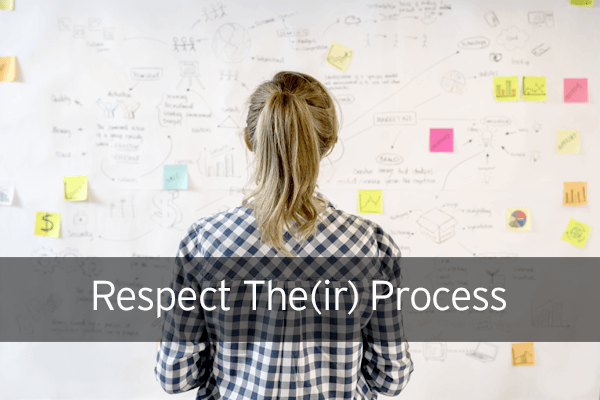The creative process: organic, nonlinear, unpredictable and very distinct to each person. Are you respecting that process? Providing a safe space for ideas to blossom?
I’ll never forget an executive from another department demanding on-the-spot ideas when I was the Creative Services Manager at a top 30 credit union. It felt like she threw down the gauntlet when she stared at me expecting innovation at that very moment. I was completely intimidated and felt my brain actually shut down instead of getting sparked. This was much earlier in my understanding of the creative process, especially of how individual it can be. I was definitely shaken by this experience. Here I am 15 years later and I still remember it like it was yesterday.
As nice and neat as we want the business world to be, coming up with ideas can often be a messy process. There are plenty of business theories, exercises, and practices available to help guide the creative process, but it still comes down to how each of us processes information, engages with others, as well as the level of psychological safety in the workplace.
For instance, introverts might need more space and time to ideate on their own before collaborating with others. Extroverts might get their ideas in that collaboration time.
Let’s take a closer look at how various personalities manifest creativity and how we can respect each other’s individual creative process.
Personalities and Creativity
Introverts, those who gain energy through inward experience, tend to do better work when they think things over before interacting with others. Extroverts, those who gain energy through outward experience, tend to use collaboration with others as the way to spark ideas. These are very different ways to approach idea generation. So we can see how something like a group brainstorming session might intimidate introverts yet extroverts could thrive in those sessions.
If we look at the Myers-Briggs profiles, this study shows those with a stronger perceiving tendencies are more apt to do innovative, creative work. The study also discovered some personality types (cognitive) might unconsciously squash creative ideas as they are highly resistant to change. So we can see how a manager with cognitive tendencies might need more encouragement to respect staff who might be more innovative.
Psychological Safety
To pave the path towards innovation and growth, your staff needs to believe they will not be ridiculed, punished or humiliated for voicing their ideas. This (among other aspects) is what it means to have psychological safety. So how can leaders and staff provide a safe environment while selecting ideas which have a better chance of success?
- Encourage inclusion: welcome all people, allowing staff to express their individuality
- Encourage learning: welcome questions and feedback
- Encourage challenges: welcome calculated risks and failures, allowing for improvements
To put some of this into action, let’s take a look at a classic creativity exercise: brainstorming. The typical set up has brainstorming as a group exercise in which a specific challenge is presented, then the participants verbalize ideas. In well-run sessions, the moderator will remind the group to defer offering an opinion of the ideas until after the ideation section is complete, but often the structure is so loose, participants will express their approval (or not) as ideas are listed. This can quickly set up an unsafe environment, one in which humiliation can creep in.
One way to address those issues is to use brainwriting instead of brainstorming. There are many approaches to brainwriting, but the overall gist of it is to generate ideas individually, then come together to discuss, refine, and collaborate.
The main approach to brainwriting has the group in the same space for the entire session:
- Describe the challenge
- Jot down ideas quickly on sticky notes within a set time
- Put sticky notes on a wall
- Walk around to review the notes/ideas individually
- Open group discussion
Another approach could be as simple as sending out the problem in question, with a time/date for a group meeting in which the attendees bring in ideas to be discussed.
This shift in how and where ideas are generated provides safety for that portion, but what about the discussion and analysis? How can we discuss ideas so the person who submitted the idea doesn’t feel they are being judged?
Establish guidelines for the discussion. This will remind the group the ideas are the focus, especially in how they relate to the initial challenge set before them. Guidelines can include:
- Keep subjective adjectives (silly, stupid, awesome, crazy, etc) to a minimum
- Use ‘this might work because’ instead of ‘I like’
- Practice curiosity and respect (phrases like ‘I wonder if….’ instead of ‘why did you…’)
- Connect the idea to the challenge itself (how does it address the problem)
Studies show brainwriting provides better ideas while providing a more inclusive process. It reduces the fear of impromptu speaking in front of a group, as well as the pressure to create-on-demand.
Changing from brainstorming to brainwriting is just one example of how we can respect each person’s creative process. Providing a work environment which feels psychologically safe to everyone is the key for honoring the creative process and each person’s take on it. When you and your organization respect that process innovation and growth are sure to follow.


